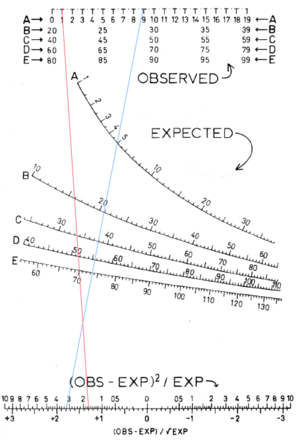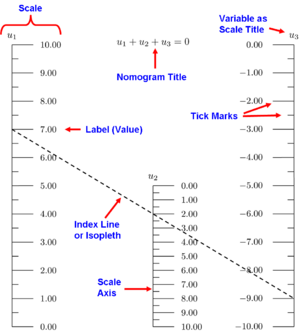Nomogram facts for kids

A nomogram (also called an alignment chart or abaque) is a special type of graph used for calculations. Think of it as a flat, two-dimensional diagram that helps you solve math problems, especially those involving complex formulas.
This clever way of calculating was invented in 1884 by a French engineer named Philbert Maurice d’Ocagne. For many years, nomograms were super helpful for engineers. They allowed them to quickly solve tricky equations without needing a calculator. Instead of using the usual X-Y graph paper, nomograms use a special "parallel coordinate system" that d'Ocagne created.
A nomogram has several scales, one for each variable (or unknown number) in a math equation. If you know the values for most of the variables, you can find the missing one. You can also see how different variables relate to each other by setting some values.
To use a nomogram, you simply place a straightedge (like a ruler) across the known values on their scales. Then, you read the answer where the straightedge crosses the scale for the unknown variable. This imaginary or drawn line is called an index line or isopleth.
How Nomograms Are Used
Nomograms were very popular for about 75 years. They made quick and accurate calculations possible long before pocket calculators were invented. Getting results from a nomogram was fast and reliable, often just by drawing one or two lines.
One great thing about nomograms is that you didn't need to be a math expert to use them. You didn't have to solve complicated algebra problems, look up numbers in big tables, or even know the exact math equation the nomogram represented. This made them very user-friendly!
Nomograms were designed with specific knowledge built into them. For example, when creating a large nomogram for better accuracy, the designer would only include number ranges that made sense for the problem. Many nomograms also had helpful labels or colored areas to guide the user. All these features made them easier to use.
Like a slide rule, a nomogram is a type of graphical analog computing device. This means it uses physical measurements (like lines on a graph) to represent numbers and solve problems. However, its accuracy depends on how precisely the lines are drawn, copied, and read. While a slide rule is a general tool, a nomogram is made for one specific calculation. Even today, nomograms can be useful for quickly checking an answer from a more exact, but possibly error-prone, calculation.
Images for kids
See also
 In Spanish: Nomograma para niños
In Spanish: Nomograma para niños







